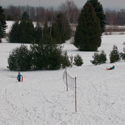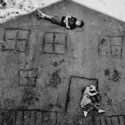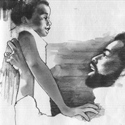We've run into old friends at Eastern Market and I'm telling a story. I forget my daughter is there.
Our neighborhood was once a true ghetto, first a neighborhood of Eastern-European Jews and then one of the only places in Detroit that black people were allowed to live. Through racist clauses common in land conveyances early in the twentieth century, blacks were not allowed to purchase or rent property in most of the city outside of what was then known as Paradise Valley and the Black Bottom. The influx of black workers from down south in the 1920s swelled the population in this neighborhood to the point where overcrowding was a major problem. Still, like the famous black neighborhoods in other cities, music and culture thrived here. Duke Ellington and Ella Fitzgerald performed regularly at the clubs in Paradise Valley. There were doctors and poets and petty criminals. The Nation of Islam was born here.
Eventually it became illegal to prevent the transfer of property to an entire race, and the neighborhood ebbed into a ramshackle slum as middle class blacks poured into other parts of the city. The old neighborhood was emptied and leveled in the 1950s for a highway and the redeveloped neighborhood designed by Mies van der Rohe where we chose to live. While digging in our garden I often find red bricks not a foot beneath the surface, all that remains of the bulldozed homes and businesses of the Black Bottom.
When we first moved here, I became enamored with the below-grade Grand Trunk Railway line that formed the eastern border of the old Black Bottom. When our neighborhood was built, they tore apart the urban fabric of streets for a series of parks and impassable cul-de-sacs. But when I started walking with the dog down in the old abandoned railway line, I got a real sense of the grid of the old neighborhood: old bridges remained over the sunken tracks that once connected streets which no longer exist. I found a nineteenth-century map of the city and spoke aloud the names of those streets: Champlain; Mullet; Sherman; Macomb. All that remained of those streets were buried bricks and bridges.
The railway line is called the Dequindre Cut, named (like most north-south streets in eastern Detroit) for the French settler whose narrow ribbon farm once stretched all the way to the river. When I first started exploring it, the cut was a wild place filled with overgrown invasive plant species, trash, and empty cans of spray paint left by the graffiti artists who'd turned an entire mile of the cut and the undersides of its bridges into the most spectacular urban canvas I have ever encountered. They called the bellies of these bridges "the caverns," and the underside of each was splashed with an ever-changing archaeology of color even the most stodgy crier of vandalism couldn't deny was art. The cut was home to a dozen homeless men, countless ring-necked pheasants, rabbits, raccoons, and even foxes. It was like a wilderness in the middle of the city, and I used to go down there several times a week.
One of those times (I tell my friends as Juniper listens from the crook of my arm) I was walking in the cut when I came across a naked man standing on a cement pylon. I made eye contact and nodded, and he nodded back. I wasn't scared and I didn't feel threatened by this naked man. It was fairly obvious he wasn't carrying any concealed weapons. It seemed a little cold to be standing on a cement pylon completely naked, but there he was.
"What was the naked man doing?" Juniper asks.
I keep telling the story, ignoring her repeated queries. After I'd walked the mile up to the market and started back, I became wary as I returned to the place where the naked homeless man had been. I need not have worried. There he was down ahead, still naked, playing a mournful song on a battered-looking trumpet.
I go on to describe how the cut has now been cleared of all its trash and brush, how the homeless men and pheasants and wild dogs have been driven out into the surrounding neighborhoods (twice now I've found a ring-necked pheasant on our doorstep). They are turning the cut into a paved biking/jogging trail, replanting native species, and connecting it to Detroit's spectacular new riverfront. For months the sound of heavy equipment knocking down those old Black Bottom bridges has started early each morning, the sound of the last traces of the old neighborhood churning into dust. Even in Detroit, where often there is no incentive to bury the past, history finds some way to disappear. It is bittersweet, I say, having loved what it was but also looking forward to what this new "safe" green space will mean for our neighborhood. Juniper tugs at my sleeve again:
"What did you say about a naked guy, Pops?"
And for two weeks I have been answering questions about the naked guy.
Every day, we go jogging and she asks me to tell her about the naked guy. I weave a story for her as she rolls through a green park that covers long-silent streets, a story not so different from the one above. I tell her about factories that once needed men and steel. I tell her about a neighborhood full of men and women and children who couldn't live anywhere else because other people were cruel and the laws unfair. I tell her how steel was brought on ships down the river and taken right past this neighborhood to the factories by steam locomotives. I tell her those factories closed and the trains were no longer needed, and then the tracks became overgrown and wild like a jungle full of plants and animals and a man came to live there and decided one day he no longer wanted to wear clothes while he played his trumpet. So he didn't, and in this jungle there was no one to tell him he had to.
My wife is not privy to these conversations.
She was having lunch with one of the kid's classmates and his mother at the market the other day, and they started talking about how nice it would be to have the paved cut connecting the market and the river. "Are you talking about the cut?" the kid asked my wife. Wood started explaining to her what the cut was. "No mama," she replied. "I know what the cut is. The cut is where the naked guy lives. The naked guy who plays his trumpet."
Copyright © 2005-2016 Sweet Juniper Media, Inc.
All Rights Reserved.
All Rights Reserved.
"Sweet Juniper" is a registered trademark.
No unauthorized reuse.
No unauthorized reuse.
Categories
- Friday Morning Street Urchin Blogging ( 107 )
- Detroit ( 60 )
- SAHD ( 34 )
- photography ( 30 )
- Thursday Morning Wood ( 25 )
- Halloween ( 23 )
- Thrift ( 18 )
- abandoned places ( 18 )
- terrifying nixon-era children's books ( 16 )
- Reminiscin' ( 15 )
- Sweet Juniper Media ( 11 )
- Wendell ( 10 )
- Design ( 9 )
- San Francisco ( 9 )
- nature fights back ( 9 )
- sleep ( 9 )
- if you ain't dutch you ain't much ( 8 )
- sentimental ( 7 )
- Music ( 6 )
- Parody ( 6 )
- birth story ( 6 )
- scrappers ( 6 )
- Sweet Juniper Tunes ( 5 )
- lawyering ( 5 )
- Zoo ( 4 )
- elegant leisure ( 4 )
- language ( 3 )
- feral houses ( 2 )
- theme parks of the damned ( 2 )
- zombies ( 1 )
Archives
- November 2017 ( 2 )
- December 2016 ( 1 )
- November 2016 ( 2 )
- December 2015 ( 1 )
- November 2015 ( 2 )
- December 2014 ( 1 )
- October 2014 ( 2 )
- April 2014 ( 1 )
- December 2013 ( 2 )
- November 2013 ( 1 )
- October 2013 ( 1 )
- September 2013 ( 2 )
- July 2013 ( 2 )
- June 2013 ( 1 )
- April 2013 ( 1 )
- March 2013 ( 3 )
- February 2013 ( 1 )
- January 2013 ( 1 )
- December 2012 ( 2 )
- November 2012 ( 1 )
- October 2012 ( 4 )
- September 2012 ( 2 )
- August 2012 ( 2 )
- July 2012 ( 1 )
- June 2012 ( 3 )
- May 2012 ( 1 )
- April 2012 ( 2 )
- March 2012 ( 1 )
- February 2012 ( 2 )
- January 2012 ( 1 )
- December 2011 ( 3 )
- November 2011 ( 3 )
- October 2011 ( 5 )
- September 2011 ( 3 )
- August 2011 ( 4 )
- July 2011 ( 4 )
- June 2011 ( 2 )
- May 2011 ( 4 )
- April 2011 ( 6 )
- March 2011 ( 7 )
- February 2011 ( 4 )
- January 2011 ( 4 )
- December 2010 ( 5 )
- November 2010 ( 7 )
- October 2010 ( 5 )
- September 2010 ( 4 )
- August 2010 ( 5 )
- July 2010 ( 7 )
- June 2010 ( 5 )
- May 2010 ( 5 )
- April 2010 ( 5 )
- March 2010 ( 4 )
- February 2010 ( 5 )
- January 2010 ( 5 )
- December 2009 ( 6 )
- November 2009 ( 5 )
- October 2009 ( 8 )
- September 2009 ( 9 )
- August 2009 ( 6 )
- July 2009 ( 9 )
- June 2009 ( 8 )
- May 2009 ( 8 )
- April 2009 ( 8 )
- March 2009 ( 12 )
- February 2009 ( 11 )
- January 2009 ( 9 )
- December 2008 ( 11 )
- November 2008 ( 9 )
- October 2008 ( 14 )
- September 2008 ( 11 )
- August 2008 ( 11 )
- July 2008 ( 12 )
- June 2008 ( 10 )
- May 2008 ( 9 )
- April 2008 ( 8 )
- March 2008 ( 10 )
- February 2008 ( 15 )
- January 2008 ( 12 )
- December 2007 ( 9 )
- November 2007 ( 12 )
- October 2007 ( 11 )
- September 2007 ( 13 )
- August 2007 ( 11 )
- July 2007 ( 8 )
- June 2007 ( 12 )
- May 2007 ( 10 )
- April 2007 ( 10 )
- March 2007 ( 12 )
- February 2007 ( 14 )
- January 2007 ( 12 )
- December 2006 ( 11 )
- November 2006 ( 10 )
- October 2006 ( 13 )
- September 2006 ( 8 )
- August 2006 ( 13 )
- July 2006 ( 13 )
- June 2006 ( 15 )
- May 2006 ( 13 )
- April 2006 ( 9 )
- March 2006 ( 10 )
- February 2006 ( 3 )
- January 2006 ( 5 )
- December 2005 ( 2 )
- November 2005 ( 8 )
- October 2005 ( 4 )
- September 2005 ( 1 )
- July 2005 ( 3 )


























